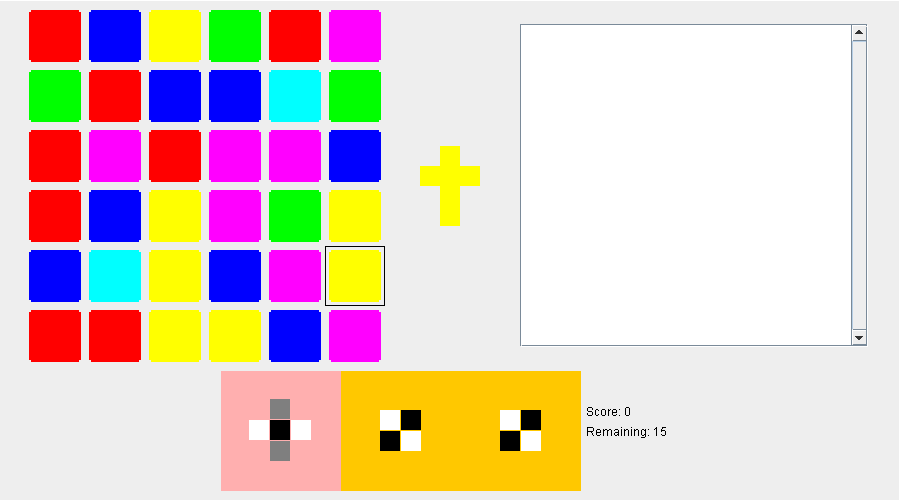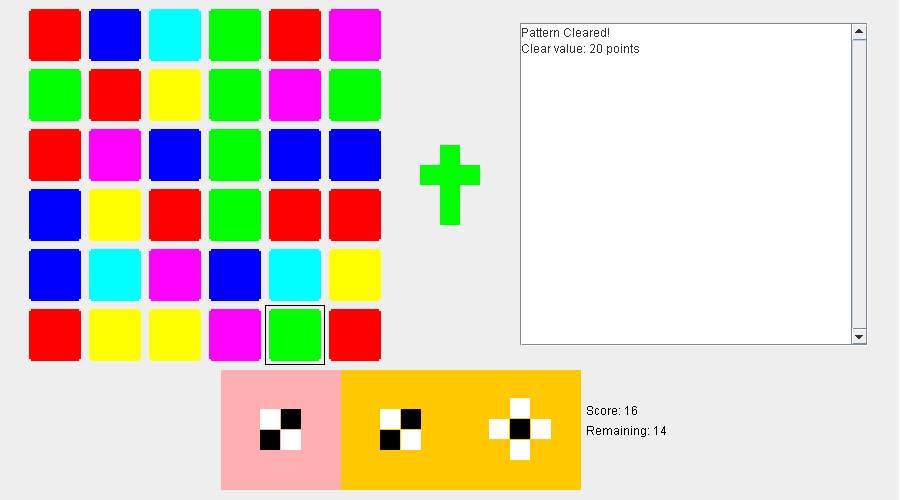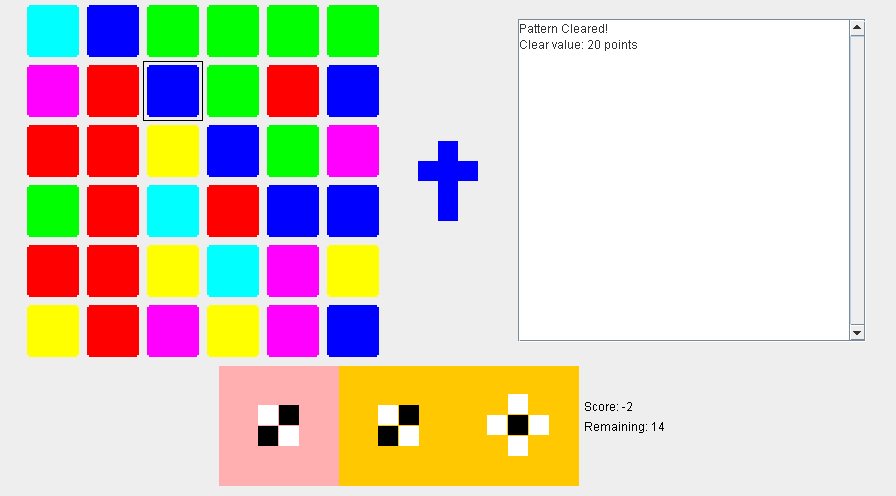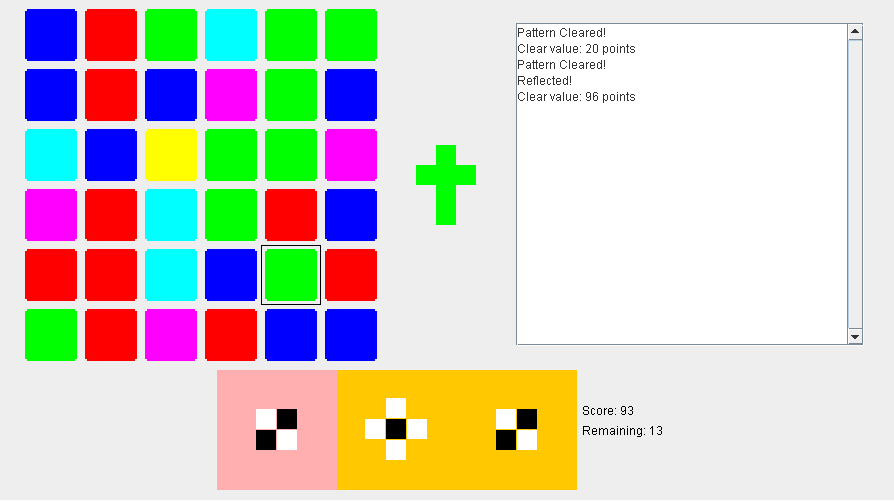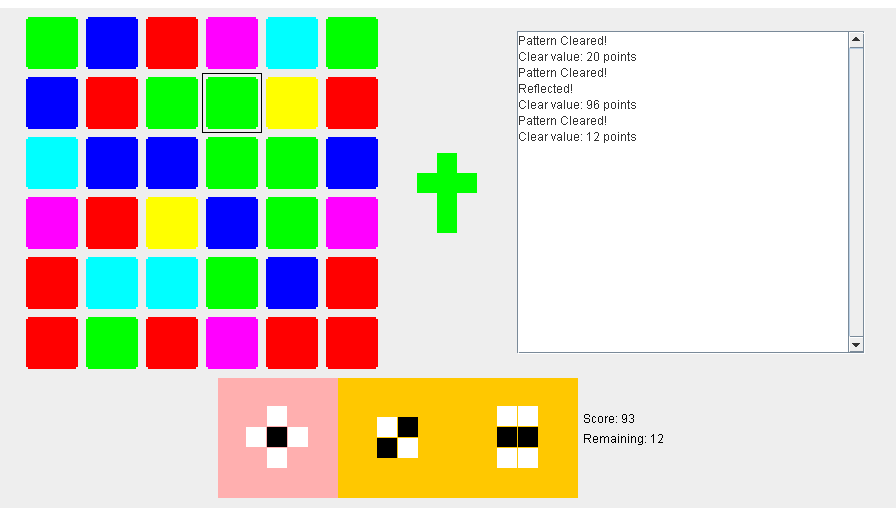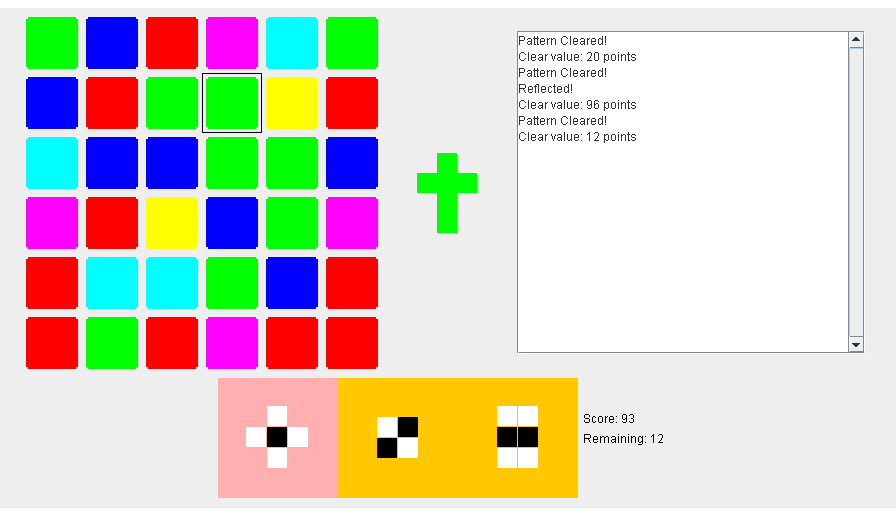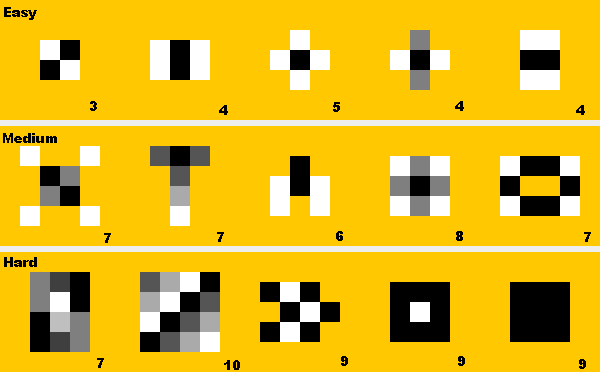GCPP:Proposal-Carp
Puzzle Codename: Carp
| Contact | |
| Username: | tanonev |
| Additional contact info: | Sage: Tanonev; Email: tanonev (AT) stanford (DOT) edu |
| Project forum thread: | discussion |
| A prototype is available for this proposal. | |
| Check it out and contribute to the design! |
Game concept
Arrange colored cubes into required shapes and patterns. Inspirations: Popcap Chuzzle, Y!PP Shipwrightery, Y!PP Duty Navigation, GCPP Haddock
Objective
Create all the patterns by rolling the cubes in rows and columns to match shape and color.
Gameplay
The board consists of a 6x6 array of colored squares, representing the tops of the cubes. One square is highlighted as the current cube. At the top right is an "unfolded" representation of the current cube. A single cube's faces may be different colors.
Use the arrow keys to change the current cube. The board "wraps around" at all edges.
Use the WASD pad to "roll" the cubes in the respective direction. For example, W will move the current cube up one position in the array, along with all of the other cubes in its column (wrapping around to the bottom of the board). In addition, each of those cubes rotate upward once, so their "south" faces are now their "top" (visible) faces and their old top faces are now their north faces.
Holding the Shift key allows you to roll the cubes without losing points or matching patterns. That way you can preview how a series of rolls will affect the board. Releasing the Shift key reverts the board to the state it was in when you first pressed the Shift key.
(NEW) Alternatively, you can use the mouse to select cubes and roll rows. Move your mouse to a cube to select it as the current cube, and click and drag it in a cardinal direction to roll it.
At the bottom is a queue of required patterns. The queue shows you the next three patterns, but only the leading (leftmost) pattern can actually be matched, at which point the queue will advance and show you more patterns. When a pattern is matched, the cubes involved in the match are cleared and new cubes enter in the same manner as a line clear.
Patterns never specify actual colors; instead, they use shades of gray to indicate the pattern of colors required. For example, one pattern may indicate a solid 2x2 block; another may indicate a single block of one color surrounded on all 4 sides by blocks of a second color.
DISCLAIMER: The colored faces are colored faces for ease of prototyping. The different colors are supposed to represent different types of materials used in a furnisher.
Storyboard
Dave, an able furnisher, decides to play the furnisher puzzle again. When he starts, he gets this:
Dave now quickly makes a clear, and the pieces fall down.
Dave decides to make a reflected combo, thus the sets up the pieces needed.
He realizes then that he only needs one move to make the next two pieces at the same time, so he then decides to make a double combo, and shifts the cubes to the spaces he wants
He thinks: Hmm.... I could probably do a Double Reflected, but I'm not sure if I can do it. He realizes that only the current piece will set off the combo, so he builds another one of the second piece.
Satisfied with his combo, Dave finishes his game and soon scores and Incredible.
Scoring
Each pattern has its own base value. More complex patterns have higher base values. Each cube also has its own base value. Solid-color cubes, for example, are worth much less than six-color cubes.
It is possible to simultaneously create multiple copies of the required pattern with one move. If this occurs, a "Mirror bonus" (Reflected, Triplicate, Fractalized) is awarded, a multiplier equal to the square of the number of copies of the pattern.
It is possible for a new match to be made after a clear occurs. If this occurs, a Chain bonus (Double, Triple, Bingo, Donkey, Vegas) is awarded, a multiplier equal to the number of clears in the chain.
NEW: If both the Chain bonus and the Mirror bonus apply to a clear, the Mirror bonus is only equal to the number of copies, not the square of the number.
1 point is deducted for every roll made.
Scoring formula:
- 3^f * d * p * m * c (* m if c=1)
- f = # of frozen cubes
- d = sum of cube values
- p = pattern value
- m = # of copies of pattern
- c = chain position
Current pattern values:
Current cube values:
- solid: 1 point
- 2-color: 2 points
- 3-color: 3 points
- 6-color: 6 points
Variability
At higher levels, a random cube may become "frozen" immediately after a clear. It glazes over and can no longer be rolled (which affects other cubes in its row and column as well). However, when it is cleared, it triples the value of the clear. This Frozen bonus is cumulative, so a pattern clear with 3 frozen cubes is worth 27 times its usual amount.
End criteria
The queue contains 15 patterns. The game ends when the queue is emptied. The game also ends if all rows and columns are frozen.
Difficulty scaling
Higher levels get harder dice to work with. At the very beginning, all cubes will be solid-color. At the highest level, there will be an abundance of 6-color cubes. This makes it harder to create clears, but at the same time, the cubes are worth more, resulting in more scoring opportunities.
Higher levels also get more complicated patterns, which are naturally worth more.
Higher levels get frozen cubes with greater frequencies, which complicates movement in exchange for greater bonuses.
Crafting type
Furnishing
Known problems
Scoring not yet balanced.
